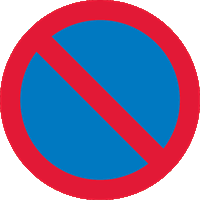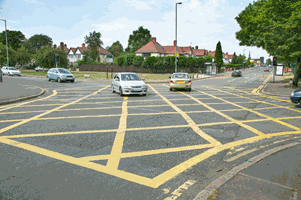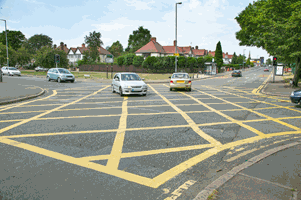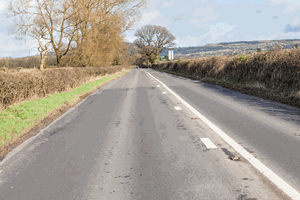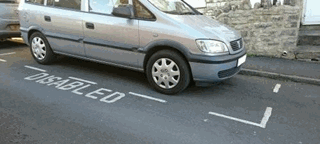There are 67 Rules of the Road Theory Test questions. You must get 86% (58 out of 67) to pass the test. You may review answers after each question by clicking the 'check answer' button or you can wait until the end of the test for your final score. Good luck!
Test Quick View
Click on an answer to view the correct choice along with the explanation.
Correct Answer: B
Explanation: This sign doesn't tell you the speed limit in figures. You should know the speed limit for the type of road that you're on and the type of vehicle that you're driving. Study your copy of The Highway Code.
Explanation: This sign doesn't tell you the speed limit in figures. You should know the speed limit for the type of road that you're on and the type of vehicle that you're driving. Study your copy of The Highway Code.
B
C
D
Correct Answer: D
Explanation: Make sure that you know the speed limit for the road that you're on. The speed limit on a dual carriageway or motorway is 70 mph for cars and motorcycles, unless signs indicate otherwise. The speed limits for different types of vehicle are listed in The Highway Code.
Explanation: Make sure that you know the speed limit for the road that you're on. The speed limit on a dual carriageway or motorway is 70 mph for cars and motorcycles, unless signs indicate otherwise. The speed limits for different types of vehicle are listed in The Highway Code.
B
C
D
Correct Answer: D
Explanation: There's a 30 mph speed limit where there are street lights unless signs show another limit.
Explanation: There's a 30 mph speed limit where there are street lights unless signs show another limit.
4. You see street lights but no speed-limit signs. What will the speed limit usually be?
Mark one answer
B
C
D
Correct Answer: A
Explanation: The presence of street lights generally indicates that there's a 30 mph speed limit, unless signs tell you otherwise.
Explanation: The presence of street lights generally indicates that there's a 30 mph speed limit, unless signs tell you otherwise.
Correct Answer: B
Explanation: The red slash through the sign indicates that the restriction has ended. In this case, the restriction was a minimum speed limit of 30 mph.
Explanation: The red slash through the sign indicates that the restriction has ended. In this case, the restriction was a minimum speed limit of 30 mph.
6. There's a tractor ahead. You want to overtake but you aren't sure whether it's safe. What should you do?
Mark one answer
B
C
D
Correct Answer: D
Explanation: Following a tractor can be frustrating, but never overtake if you're unsure whether it's safe. Ask yourself: 'Can I see far enough down the road to ensure that I can complete the manoeuvre safely?' It's better to be delayed for a minute or two than to take a chance that may cause a collision.
Explanation: Following a tractor can be frustrating, but never overtake if you're unsure whether it's safe. Ask yourself: 'Can I see far enough down the road to ensure that I can complete the manoeuvre safely?' It's better to be delayed for a minute or two than to take a chance that may cause a collision.
Correct Answer: C
Explanation: Long vehicles might have to take a slightly different position when approaching the roundabout or going around it. This is to stop the rear of the vehicle cutting in and mounting the kerb.
Explanation: Long vehicles might have to take a slightly different position when approaching the roundabout or going around it. This is to stop the rear of the vehicle cutting in and mounting the kerb.
Correct Answer: A
Explanation: Clearways are in place so that traffic can flow without the obstruction of parked vehicles. Just one parked vehicle can cause an obstruction for all other traffic. You mustn't stop where a clearway is in force, not even to pick up or set down passengers.
Explanation: Clearways are in place so that traffic can flow without the obstruction of parked vehicles. Just one parked vehicle can cause an obstruction for all other traffic. You mustn't stop where a clearway is in force, not even to pick up or set down passengers.
Correct Answer: D
Explanation: This sign indicates that there are waiting restrictions. It's normally accompanied by details of when the restrictions are in force. Details of most signs in common use are shown in The Highway Code. For more comprehensive coverage, see Know Your Traffic Signs.
Explanation: This sign indicates that there are waiting restrictions. It's normally accompanied by details of when the restrictions are in force. Details of most signs in common use are shown in The Highway Code. For more comprehensive coverage, see Know Your Traffic Signs.
Correct Answer: B
Explanation: Red rear reflectors show up when headlights shine on them. These are useful when you're parked at night, but they'll only reflect if you park in the same direction as the traffic flow. Normally you should park on the left, but in a one-way street you may also park on the right-hand side.
Explanation: Red rear reflectors show up when headlights shine on them. These are useful when you're parked at night, but they'll only reflect if you park in the same direction as the traffic flow. Normally you should park on the left, but in a one-way street you may also park on the right-hand side.
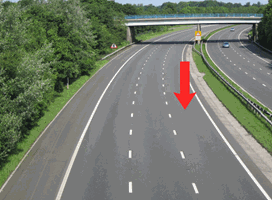
B
C
D
Correct Answer: C
Explanation: You should normally use the left-hand lane on any dual carriageway unless you're overtaking or turning right. When overtaking on a dual carriageway, look for vehicles ahead that are turning right. They may be slowing or stopped. You need to see them in good time so that you can take appropriate action.
Explanation: You should normally use the left-hand lane on any dual carriageway unless you're overtaking or turning right. When overtaking on a dual carriageway, look for vehicles ahead that are turning right. They may be slowing or stopped. You need to see them in good time so that you can take appropriate action.
12. You're approaching a busy junction. What should you do when, at the last moment, you realise you're in the wrong lane?
Mark one answer
B
C
D
Correct Answer: A
Explanation: There are times when road markings are obscured by queuing traffic, or you're unsure which lane to use. If, at the last moment, you find you're in the wrong lane, don't cut across or bully other drivers to let you in. Follow the lane you're in and find somewhere safe to turn around and rejoin your route.
Explanation: There are times when road markings are obscured by queuing traffic, or you're unsure which lane to use. If, at the last moment, you find you're in the wrong lane, don't cut across or bully other drivers to let you in. Follow the lane you're in and find somewhere safe to turn around and rejoin your route.
Correct Answer: A
Explanation: You can overtake other traffic on either side when travelling in a one-way street. Make full use of your mirrors and ensure it's clear all around before you attempt to overtake. Look for signs and road markings, and use the most suitable lane for your destination.
Explanation: You can overtake other traffic on either side when travelling in a one-way street. Make full use of your mirrors and ensure it's clear all around before you attempt to overtake. Look for signs and road markings, and use the most suitable lane for your destination.
Correct Answer: B
Explanation: When going straight ahead at a roundabout, don't signal as you approach it. Indicate left just after passing the exit before the one you wish to take.
Explanation: When going straight ahead at a roundabout, don't signal as you approach it. Indicate left just after passing the exit before the one you wish to take.
B
C
D
Correct Answer: B
Explanation: A long vehicle may have to straddle lanes either on or approaching a roundabout so that the rear wheels don't hit the kerb. If you're following a long vehicle, stay well back and give it plenty of room.
Explanation: A long vehicle may have to straddle lanes either on or approaching a roundabout so that the rear wheels don't hit the kerb. If you're following a long vehicle, stay well back and give it plenty of room.
Correct Answer: D
Explanation: Yellow box junctions are marked on the road to prevent the road becoming blocked. Don't enter the box unless your exit road is clear. You may wait in the box if you want to turn right and your exit road is clear but oncoming traffic or other vehicles waiting to turn right are preventing you from making the turn.
Explanation: Yellow box junctions are marked on the road to prevent the road becoming blocked. Don't enter the box unless your exit road is clear. You may wait in the box if you want to turn right and your exit road is clear but oncoming traffic or other vehicles waiting to turn right are preventing you from making the turn.
Correct Answer: A
Explanation: The purpose of yellow box markings is to keep junctions clear of queuing traffic. You may only wait in the marked area when you're turning right and your exit lane is clear but you can't complete the turn because of oncoming traffic or other traffic waiting to turning right.
Explanation: The purpose of yellow box markings is to keep junctions clear of queuing traffic. You may only wait in the marked area when you're turning right and your exit lane is clear but you can't complete the turn because of oncoming traffic or other traffic waiting to turning right.
Correct Answer: D
Explanation: You must obey signals to stop given by police and traffic officers, traffic wardens and school crossing patrols. Failure to do so is an offence and could lead to prosecution.
Explanation: You must obey signals to stop given by police and traffic officers, traffic wardens and school crossing patrols. Failure to do so is an offence and could lead to prosecution.
B
C
D
Correct Answer: D
Explanation: By standing on the pavement, the pedestrian is showing an intention to cross. By looking well ahead, you'll give yourself time to see the pedestrian, check your mirrors and respond safely.
Explanation: By standing on the pavement, the pedestrian is showing an intention to cross. By looking well ahead, you'll give yourself time to see the pedestrian, check your mirrors and respond safely.
Correct Answer: C
Explanation: Toucan crossings are similar to pelican crossings but there's no flashing amber phase. Cyclists share the crossing with pedestrians and are allowed to cycle across when the green cycle symbol is shown.
Explanation: Toucan crossings are similar to pelican crossings but there's no flashing amber phase. Cyclists share the crossing with pedestrians and are allowed to cycle across when the green cycle symbol is shown.
21. You're waiting at a pelican crossing. What does it mean when the red light changes to flashing amber?
Mark one answer
B
C
D
Correct Answer: C
Explanation: This light allows pedestrians already on the crossing to get to the other side in their own time, without being rushed. Don't rev your engine or start to move off while they're still crossing.
Explanation: This light allows pedestrians already on the crossing to get to the other side in their own time, without being rushed. Don't rev your engine or start to move off while they're still crossing.
Correct Answer: C
Explanation: You mustn't park or stop on a road marked with double white lines (even where one of the lines is broken) except to pick up or set down passengers.
Explanation: You mustn't park or stop on a road marked with double white lines (even where one of the lines is broken) except to pick up or set down passengers.
23. You're turning right at a crossroads. An oncoming driver is also turning right. How should you normally deal with this?
Mark one answer
B
C
D
Correct Answer: D
Explanation: At crossroads, traffic normally turns offside to offside. This is the safest way to turn, but sometimes the layout or road markings indicate drivers should pass nearside to nearside. Take extra care at these crossroads because, as you turn, your view ahead will be obscured by the oncoming vehicle crossing in front of you.
Explanation: At crossroads, traffic normally turns offside to offside. This is the safest way to turn, but sometimes the layout or road markings indicate drivers should pass nearside to nearside. Take extra care at these crossroads because, as you turn, your view ahead will be obscured by the oncoming vehicle crossing in front of you.
24. You're travelling along a street with parked vehicles on the left-hand side. Why should you keep your speed down?
Mark one answer
B
C
D
Correct Answer: A
Explanation: Travel slowly and carefully near parked vehicles. Beware of
- vehicles pulling out, especially bicycles and motorcycles
- pedestrians, especially children, who may run out from between cars
- drivers opening their doors
Explanation: Travel slowly and carefully near parked vehicles. Beware of
- vehicles pulling out, especially bicycles and motorcycles
- pedestrians, especially children, who may run out from between cars
- drivers opening their doors
Correct Answer: C
Explanation: Take care if you have to pass a parked vehicle on your side of the road. Give way to oncoming traffic if there isn't enough room for you both to continue safely.
Explanation: Take care if you have to pass a parked vehicle on your side of the road. Give way to oncoming traffic if there isn't enough room for you both to continue safely.
B
C
D
Correct Answer: C
Explanation: Normally you should travel in the left-hand lane and only use the right-hand lane for overtaking or turning right. Move back into the left lane as soon as it's safe but don't cut in across the path of the vehicle you've just passed.
Explanation: Normally you should travel in the left-hand lane and only use the right-hand lane for overtaking or turning right. Move back into the left lane as soon as it's safe but don't cut in across the path of the vehicle you've just passed.
Correct Answer: A
Explanation: Practise good observation in all directions before you emerge or make a turn. Proceed only when you're sure it's safe to do so.
Explanation: Practise good observation in all directions before you emerge or make a turn. Proceed only when you're sure it's safe to do so.
Correct Answer: A
Explanation: Don't park within 10 metres (32 feet) of a junction (unless in an authorised parking place). This is to allow drivers emerging from, or turning into, the junction a clear view of the road they're joining. It also allows them to see hazards such as pedestrians or cyclists at the junction.
Explanation: Don't park within 10 metres (32 feet) of a junction (unless in an authorised parking place). This is to allow drivers emerging from, or turning into, the junction a clear view of the road they're joining. It also allows them to see hazards such as pedestrians or cyclists at the junction.
Correct Answer: A
Explanation: It may be tempting to park where you shouldn't while you run a quick errand. Careless parking is a selfish act and could endanger other road users. It's important not to park at or near a bus stop, as this could inconvenience passengers and may put them at risk as they get on or off the bus.
Explanation: It may be tempting to park where you shouldn't while you run a quick errand. Careless parking is a selfish act and could endanger other road users. It's important not to park at or near a bus stop, as this could inconvenience passengers and may put them at risk as they get on or off the bus.
30. You're waiting at a level crossing. A train passes but the lights keep flashing. What must you do?
Mark one answer
B
C
D
Correct Answer: A
Explanation: If the lights at a level crossing keep flashing after a train has passed, you should continue to wait, because another train might be coming. Time seems to pass slowly when you're held up in a queue. Be patient and wait until the lights stop flashing.
Explanation: If the lights at a level crossing keep flashing after a train has passed, you should continue to wait, because another train might be coming. Time seems to pass slowly when you're held up in a queue. Be patient and wait until the lights stop flashing.
Correct Answer: D
Explanation: The blue-and-red circular sign on its own means that waiting restrictions are in force. This sign shows that you're leaving the controlled zone and waiting restrictions no longer apply.
Explanation: The blue-and-red circular sign on its own means that waiting restrictions are in force. This sign shows that you're leaving the controlled zone and waiting restrictions no longer apply.
32. What must you do when entering roadworks where a temporary speed limit is displayed?
Mark one answer
B
C
D
Correct Answer: C
Explanation: Where there are extra hazards, such as at roadworks, it's often necessary to slow traffic down by imposing a lower speed limit. These speed limits aren't advisory; they must be obeyed.
Explanation: Where there are extra hazards, such as at roadworks, it's often necessary to slow traffic down by imposing a lower speed limit. These speed limits aren't advisory; they must be obeyed.
33. You're on a well-lit road at night, in a built-up area. How will using dipped headlights help?
Mark one answer
B
C
D
Correct Answer: A
Explanation: You may be difficult to see when you're travelling at night, even on a well-lit road. If you use dipped headlights rather than sidelights, other road users should be able to see you more easily.
Explanation: You may be difficult to see when you're travelling at night, even on a well-lit road. If you use dipped headlights rather than sidelights, other road users should be able to see you more easily.
34. The dual carriageway you're turning right onto has a very narrow central reservation. What should you do?
Mark one answer
B
C
D
Correct Answer: D
Explanation: When the central reservation is narrow, you should treat a dual carriageway as one road. Wait until the road is clear in both directions before emerging to turn right. If you try to treat it as two separate roads and wait in the middle, you're likely to cause an obstruction and possibly a collision.
Explanation: When the central reservation is narrow, you should treat a dual carriageway as one road. Wait until the road is clear in both directions before emerging to turn right. If you try to treat it as two separate roads and wait in the middle, you're likely to cause an obstruction and possibly a collision.
35. What's the national speed limit on a single carriageway road for cars and motorcycles?
Mark one answer
B
C
D
Correct Answer: C
Explanation: Exceeding the speed limit is dangerous and can result in you receiving penalty points on your licence. It isn't worth it. You should know the speed limit for the road that you're on by observing the road signs. Different speed limits apply if you're towing a trailer.
Explanation: Exceeding the speed limit is dangerous and can result in you receiving penalty points on your licence. It isn't worth it. You should know the speed limit for the road that you're on by observing the road signs. Different speed limits apply if you're towing a trailer.
Correct Answer: D
Explanation: You must use parking lights when parking at night on a road or in a lay-by on a road with a speed limit greater than 30 mph. You must also park in the direction of the traffic flow and not close to a junction.
Explanation: You must use parking lights when parking at night on a road or in a lay-by on a road with a speed limit greater than 30 mph. You must also park in the direction of the traffic flow and not close to a junction.
Correct Answer: A
Explanation: If there's a bend just before a level crossing, you may not be able to see the level-crossing barriers or waiting traffic. These signs give you an early warning that you may find these hazards just around the bend.
Explanation: If there's a bend just before a level crossing, you may not be able to see the level-crossing barriers or waiting traffic. These signs give you an early warning that you may find these hazards just around the bend.
38. You're travelling on a motorway in England. You must stop when signalled to do so by which of these?
Mark one answer
B
C
D
Correct Answer: B
Explanation: You'll find traffic officers on England's motorways. They work in partnership with the police, helping to keep traffic moving and helping to make your journey as safe as possible. It's an offence not to comply with the directions given by a traffic officer.
Explanation: You'll find traffic officers on England's motorways. They work in partnership with the police, helping to keep traffic moving and helping to make your journey as safe as possible. It's an offence not to comply with the directions given by a traffic officer.
Correct Answer: B
Explanation: To go straight ahead at a roundabout, you should normally approach in the left-hand lane, but check the road markings. At some roundabouts, the left lane on approach is marked 'left turn only', so make sure you use the correct lane to go ahead. You won't normally need to signal as you approach, but signal before you leave the roundabout, as other road users need to know your intentions.
Explanation: To go straight ahead at a roundabout, you should normally approach in the left-hand lane, but check the road markings. At some roundabouts, the left lane on approach is marked 'left turn only', so make sure you use the correct lane to go ahead. You won't normally need to signal as you approach, but signal before you leave the roundabout, as other road users need to know your intentions.
Correct Answer: B
Explanation: It's illegal to drive on or over a footpath, except to gain access to a property. If you need to cross a pavement, give priority to pedestrians.
Explanation: It's illegal to drive on or over a footpath, except to gain access to a property. If you need to cross a pavement, give priority to pedestrians.
41. A single carriageway road has this sign. What's the maximum permitted speed for a car towing a trailer?
Mark one answer
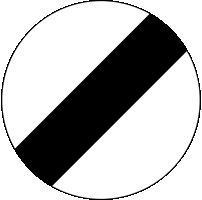
B
C
D
Correct Answer: C
Explanation: When you're towing a trailer, a reduced speed limit also applies on dual carriageways and motorways. These lower speed limits apply to vehicles pulling all sorts of trailers, including caravans and horse boxes.
Explanation: When you're towing a trailer, a reduced speed limit also applies on dual carriageways and motorways. These lower speed limits apply to vehicles pulling all sorts of trailers, including caravans and horse boxes.
42. What's the speed limit for a car towing a small caravan along a dual carriageway?
Mark one answer
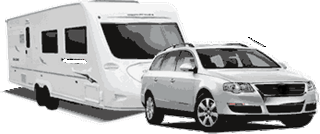
B
C
D
Correct Answer: C
Explanation: The speed limit for cars towing caravans or trailers on dual carriageways or motorways is 60 mph. Due to the increased weight and size of the combination, you should plan further ahead. Take care in windy weather, as a strong side wind can make a caravan or large trailer unstable.
Explanation: The speed limit for cars towing caravans or trailers on dual carriageways or motorways is 60 mph. Due to the increased weight and size of the combination, you should plan further ahead. Take care in windy weather, as a strong side wind can make a caravan or large trailer unstable.
43. You want to park and you see this sign. What should you do on the days and times shown?
Mark one answer
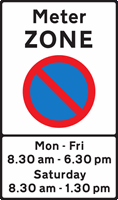
B
C
D
Correct Answer: B
Explanation: Parking restrictions apply in a variety of places and situations. Make sure you know the rules and understand where and when restrictions apply. Controlled parking areas will be indicated by signs and road markings. Parking in the wrong place could cause an obstruction and danger to other traffic. It can also result in a fine.
Explanation: Parking restrictions apply in a variety of places and situations. Make sure you know the rules and understand where and when restrictions apply. Controlled parking areas will be indicated by signs and road markings. Parking in the wrong place could cause an obstruction and danger to other traffic. It can also result in a fine.
44. A cycle lane, marked by a solid white line, is in operation. What does this mean for car drivers?
Mark one answer
B
C
D
Correct Answer: D
Explanation: Leave the lane free for cyclists. At other times, when the lane isn't in operation, you should still be aware that there may be cyclists about. Give them plenty of room as you pass and allow for their movement from side to side, especially in windy weather or on a bumpy road.
Explanation: Leave the lane free for cyclists. At other times, when the lane isn't in operation, you should still be aware that there may be cyclists about. Give them plenty of room as you pass and allow for their movement from side to side, especially in windy weather or on a bumpy road.
45. You intend to turn left from a main road into a minor road. What should you do as you approach it?
Mark one answer
B
C
D
Correct Answer: C
Explanation: Your road position can help other road users to anticipate your actions. Keep to the left as you approach a left turn and don't swing out into the centre of the road in order to make the turn easier. This could endanger oncoming traffic and may cause other road users to misunderstand your intentions.
Explanation: Your road position can help other road users to anticipate your actions. Keep to the left as you approach a left turn and don't swing out into the centre of the road in order to make the turn easier. This could endanger oncoming traffic and may cause other road users to misunderstand your intentions.
46. You're waiting at a level crossing. The red warning lights continue to flash after a train has passed by. What should you do?
Mark one answer

B
C
D
Correct Answer: A
Explanation: At a level crossing, flashing red lights mean you must stop. If the train passes but the lights keep flashing, wait. Another train may be coming.
Explanation: At a level crossing, flashing red lights mean you must stop. If the train passes but the lights keep flashing, wait. Another train may be coming.
47. You're driving over a level crossing. The warning lights come on and a bell rings. What should you do?
Mark one answer
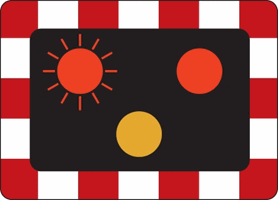
B
C
D
Correct Answer: B
Explanation: Keep going; don't stop on the crossing. If the amber warning lights come on as you're approaching the crossing, you must stop unless it's unsafe to do so. Red flashing lights together with an audible signal mean you must stop.
Explanation: Keep going; don't stop on the crossing. If the amber warning lights come on as you're approaching the crossing, you must stop unless it's unsafe to do so. Red flashing lights together with an audible signal mean you must stop.
48. You're on a busy main road and find that you're travelling in the wrong direction. What should you do?
Mark one answer
B
C
D
Correct Answer: C
Explanation: Don't turn around in a busy street or reverse from a side road into a main road. Find a quiet side road and choose a place where you won't obstruct an entrance or exit. Look out for pedestrians and cyclists as well as other traffic.
Explanation: Don't turn around in a busy street or reverse from a side road into a main road. Find a quiet side road and choose a place where you won't obstruct an entrance or exit. Look out for pedestrians and cyclists as well as other traffic.
Correct Answer: D
Explanation: You may remove your seat belt while you're carrying out a manoeuvre that includes reversing. However, you must remember to put it back on again before you resume driving.
Explanation: You may remove your seat belt while you're carrying out a manoeuvre that includes reversing. However, you must remember to put it back on again before you resume driving.
Correct Answer: B
Explanation: You mustn't reverse further than is necessary. You may decide to turn your vehicle around by reversing into an opening or side road. When you reverse, always look all around you, and watch for pedestrians. Don't reverse from a side road into a main road.
Explanation: You mustn't reverse further than is necessary. You may decide to turn your vehicle around by reversing into an opening or side road. When you reverse, always look all around you, and watch for pedestrians. Don't reverse from a side road into a main road.
51. What should you do when you're unsure whether it's safe to reverse your vehicle?
Mark one answer
B
C
D
Correct Answer: A
Explanation: A small child could be hidden directly behind you, so, if you can't see all around your vehicle, get out and have a look. You could also ask someone reliable outside the vehicle to guide you.
Explanation: A small child could be hidden directly behind you, so, if you can't see all around your vehicle, get out and have a look. You could also ask someone reliable outside the vehicle to guide you.
Correct Answer: B
Explanation: Don't reverse into a main road from a side road. The main road is likely to be busy and the traffic on it moving quickly.
Explanation: Don't reverse into a main road from a side road. The main road is likely to be busy and the traffic on it moving quickly.
53. You want to turn right at a box junction. There's oncoming traffic. What should you do?
Mark one answer
B
C
D
Correct Answer: D
Explanation: You can wait in the box junction as long as your exit is clear. At some point there'll be a gap in the oncoming traffic, or the traffic lights will change, allowing you to proceed.
Explanation: You can wait in the box junction as long as your exit is clear. At some point there'll be a gap in the oncoming traffic, or the traffic lights will change, allowing you to proceed.
54. You're reversing your vehicle into a side road. When would the greatest hazard to passing traffic occur?
Mark one answer
B
C
D
Correct Answer: D
Explanation: Always check in all directions before reversing into a side road. Keep a good lookout throughout the manoeuvre. Act on what you see and wait if necessary.
Explanation: Always check in all directions before reversing into a side road. Keep a good lookout throughout the manoeuvre. Act on what you see and wait if necessary.
Correct Answer: A
Explanation: If you have a garage, use it. Your vehicle is less likely to be a victim of car crime if it's in a garage. Also, in winter, the windows will be kept free from ice and snow.
Explanation: If you have a garage, use it. Your vehicle is less likely to be a victim of car crime if it's in a garage. Also, in winter, the windows will be kept free from ice and snow.
Correct Answer: C
Explanation: Urban clearways have their times of operation clearly signed. You may stop only for as long as is reasonable to pick up or set down passengers. You should ensure that you're not causing an obstruction for other traffic.
Explanation: Urban clearways have their times of operation clearly signed. You may stop only for as long as is reasonable to pick up or set down passengers. You should ensure that you're not causing an obstruction for other traffic.
57. You're looking for somewhere to park your vehicle. The area is full except for spaces marked 'disabled use'. What can you do?
Mark one answer
B
C
D
Correct Answer: D
Explanation: It's illegal to park in a space reserved for disabled users unless you're permitted to do so. These spaces are provided for people with limited mobility, who may need extra space to get in and out of their vehicle.
Explanation: It's illegal to park in a space reserved for disabled users unless you're permitted to do so. These spaces are provided for people with limited mobility, who may need extra space to get in and out of their vehicle.
58. You're on a road that's only wide enough for one vehicle. A car is coming towards you. What should you do?
Mark one answer
B
C
D
Correct Answer: C
Explanation: Pull into the nearest passing place on the left if you meet another vehicle on a narrow road. If the nearest passing place is on the right, wait opposite it.
Explanation: Pull into the nearest passing place on the left if you meet another vehicle on a narrow road. If the nearest passing place is on the right, wait opposite it.
59. You're driving at night with your headlights on full beam. A vehicle is overtaking you. When should you dip your lights?
Mark one answer
B
C
D
Correct Answer: A
Explanation: On full beam, your lights could dazzle the driver in front. Dip your lights as soon as the driver passes you and drop back so that the dipped beam falls short of the other vehicle.
Explanation: On full beam, your lights could dazzle the driver in front. Dip your lights as soon as the driver passes you and drop back so that the dipped beam falls short of the other vehicle.
Correct Answer: A
Explanation: Some bus lanes operate only during peak hours and other vehicles may use them outside these hours. Make sure you check the sign for the hours of operation before driving in a bus lane.
Explanation: Some bus lanes operate only during peak hours and other vehicles may use them outside these hours. Make sure you check the sign for the hours of operation before driving in a bus lane.
B
C
D
Correct Answer: A
Explanation: Your brake lights will give an indication to traffic behind that you're slowing down. Good anticipation will allow you time to check your mirrors before slowing.
Explanation: Your brake lights will give an indication to traffic behind that you're slowing down. Good anticipation will allow you time to check your mirrors before slowing.
62. You're parked in a busy high street. What's the safest way to turn your vehicle around so you can go the opposite way?
Mark one answer
B
C
D
Correct Answer: C
Explanation: Make sure you carry out the manoeuvre without causing a hazard to other vehicles. Choose a place to turn that's safe and convenient for you and for other road users.
Explanation: Make sure you carry out the manoeuvre without causing a hazard to other vehicles. Choose a place to turn that's safe and convenient for you and for other road users.
Correct Answer: B
Explanation: Whenever possible, park in an area that will be well lit at night.
Explanation: Whenever possible, park in an area that will be well lit at night.
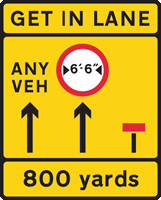
B
C
D
Correct Answer: C
Explanation: Keep a lookout for traffic signs. If you're directed to change lanes, do so in good time. Don't
- push your way into traffic in another lane
- try to gain advantage by delaying changing lanes
Explanation: Keep a lookout for traffic signs. If you're directed to change lanes, do so in good time. Don't
- push your way into traffic in another lane
- try to gain advantage by delaying changing lanes
65. You're driving on a road that has a cycle lane. The lane is marked by a broken white line. What does this mean?
Mark one answer
B
C
D
Correct Answer: D
Explanation: Cycle lanes are marked with either a solid or a broken white line. If the line is solid, you should check the times of operation shown on the signs, and not drive or park in the lane during those times. If the line is broken, you shouldn't drive or park in the lane unless it's unavoidable.
Explanation: Cycle lanes are marked with either a solid or a broken white line. If the line is solid, you should check the times of operation shown on the signs, and not drive or park in the lane during those times. If the line is broken, you shouldn't drive or park in the lane unless it's unavoidable.
Correct Answer: A
Explanation: Don't park in a space reserved for disabled people unless you or your passenger are a disabled badge holder. The badge must be displayed in your vehicle, in the bottom left-hand corner of the windscreen.
Explanation: Don't park in a space reserved for disabled people unless you or your passenger are a disabled badge holder. The badge must be displayed in your vehicle, in the bottom left-hand corner of the windscreen.
Correct Answer: D
Explanation: You must stop your vehicle when signalled to do so by a
- police or traffic officer
- traffic warden
- school crossing patrol
- red traffic light.
You must also stop if you're involved in an incident which causes damage or injury to any other person, vehicle, animal or property.
Explanation: You must stop your vehicle when signalled to do so by a
- police or traffic officer
- traffic warden
- school crossing patrol
- red traffic light.
You must also stop if you're involved in an incident which causes damage or injury to any other person, vehicle, animal or property.





